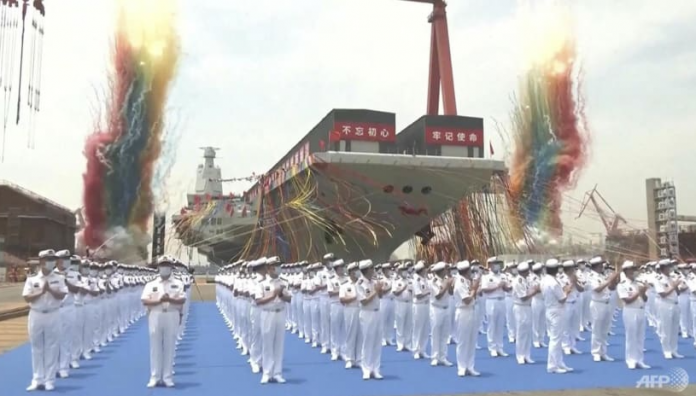China’s largest – and first to be fully designed and built domestically – aircraft carrier was launched in June amid huge fanfare. The new ship is set to be the People’s Liberation Army Navy’s most advanced vessel when it enters service eventually.
Named the Fujian, after the province just across from Taiwan, the new aircraft carrier is seen by some as a defiant signal of power at a time when cross-strait tensions have risen.
The Fujian will join two other Chinese carriers already in service: The Liaoning, a refurbished Soviet ship bought from Ukraine as a partially built hulk, and the Shandong, the first to be built in China based on the former.
It is uncertain when the Fujian will be commissioned, given the testing and sea trials still ahead. Its new technology and capabilities will require additional time for deck and aircrew to become operationally proficient.
So it will not be surprising if the ship will be considered operationally ready three years from now. But there is no question that the Fujian would alter the balance of power in Asia, such as in the East China Sea and South China Sea.
ALTERED BALANCE OF POWER
China has drastically modernised its navy over the last two decades and it is currently the largest navy in the world in terms of the number of ships in service.
A new, larger aircraft carrier will no doubt add to its peacetime prestige, adding credence to its status as a “blue-water” navy – capable of operating globally. It could be used as a floating base in the event of crisis abroad, such as for conducting humanitarian assistance or non-combatant evacuation, as a projection of soft power.
Against the backdrop of territorial disputes in regional waters, it could also be used to project hard power and execute coercive tactics.
But it is still behind the United States in terms of aircraft carrier numbers and capabilities. The US navy has 11 nuclear-powered aircraft carriers that gives it global reach, including one based in Japan and four based on the US west coast.
The US also has unparalleled experience with carrier operation gleaned from almost 90 years of fielding such ships, including combat experience during World War II, the Korean, Vietnam and 1991 Gulf wars, and the War on Terror.
It has however struggled to bring the first ship of the new Gerald R Ford-class of carriers to combat readiness.
CHINESE NAVY’S NEW CAPABILITIES
The Fujian is the first Chinese aircraft carrier equipped with an electromagnetic catapult aircraft launch system, which bestows several advantages: It should be able to launch more aircraft at a time, with shorter time between launches, and is less limiting in the weight and type of aircraft used.
With two main catapults and a third on the side, the Fujian can theoretically launch two aircraft simultaneously and a third soon after. A typical US Navy carrier has four catapults but are mostly steam-operated.
Electromagnetic catapult systems weigh less, take up less space and energy, require less maintenance and manpower, and recharge more quickly between launches. However, they are a relatively new technology, and China might face similar challenges to the US navy – like reliability – in fully developing this system. CNA




